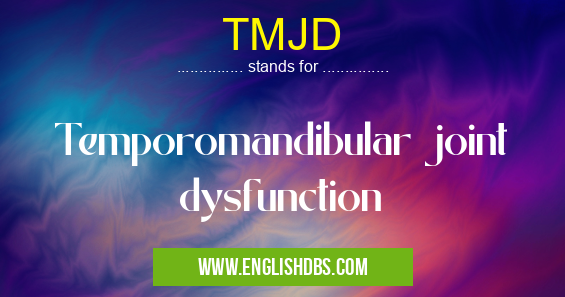What does TMJD mean in THERAPY
TMJD, an acronym that has become synonymous with a prevalent condition affecting the temporomandibular joint, which acts as a hinge connecting the jawbone to the skull. This dysfunction can manifest in a myriad of symptoms that range from mild discomfort to severe pain.

TMJD meaning in Therapy in Medical
TMJD mostly used in an acronym Therapy in Category Medical that means Temporomandibular joint dysfunction
Shorthand: TMJD,
Full Form: Temporomandibular joint dysfunction
For more information of "Temporomandibular joint dysfunction", see the section below.
TMJD: Meaning and Causes
TMJD stands for Temporomandibular Joint Dysfunction. It refers to a group of conditions affecting the temporomandibular joint (TMJ), causing pain and discomfort in the jaw, face, head, and neck. TMJD can arise from various factors, including:
- Muscle tension or strain in the jaw
- Injury to the TMJ or surrounding structures
- Misalignment of the bite
- Arthritis or other degenerative conditions
- Stress or habits like teeth grinding (bruxism)
Symptoms of TMJD
TMJD symptoms can vary widely, presenting as:
- Pain in the jaw, face, or ear
- Clicking or popping sounds in the TMJ
- Difficulty or discomfort while chewing or opening the mouth
- Headaches
- Neck pain or stiffness
- Facial swelling
Diagnosis and Treatment
Diagnosing TMJD typically involves a comprehensive physical examination and a review of the patient's medical history. Imaging tests, such as X-rays or MRI, may be employed to visualize the TMJ and surrounding structures for further evaluation.
Treatment for TMJD aims to alleviate pain, restore proper jaw function, and address underlying causes. It may encompass:
- Medications for pain relief and muscle relaxation
- Bite guards or splints to correct bite alignment
- Physical therapy to strengthen jaw muscles and improve mobility
- Stress management techniques
- Surgery, in severe cases, to repair or replace damaged joint components
Essential Questions and Answers on Temporomandibular joint dysfunction in "MEDICAL»THERAPY"
What is TMJD?
Temporomandibular joint dysfunction (TMJD) is a condition that affects the temporomandibular joint (TMJ), which connects the jaw to the skull. TMJD can cause pain, clicking, popping, or locking of the jaw. It can also lead to headaches, earaches, and difficulty chewing.
What are the symptoms of TMJD?
The symptoms of TMJD can vary, but may include:
- Jaw pain
- Clicking, popping, or locking of the jaw
- Headaches
- Earaches
- Difficulty chewing
- Facial pain
- Muscle tension in the face or neck
What causes TMJD?
The exact cause of TMJD is unknown, but it is believed to be caused by a combination of factors, including:
- Muscle tension
- Arthritis
- Injury to the jaw
- Misalignment of the teeth
- Stress
How is TMJD diagnosed?
TMJD is diagnosed through a physical examination of the jaw and a discussion of the patient's symptoms. The doctor may also order imaging tests, such as an X-ray or MRI, to rule out other conditions.
How is TMJD treated?
The treatment for TMJD will depend on the severity of the condition. Treatment options may include:
- Self-care measures, such as applying heat or ice to the jaw, eating soft foods, and avoiding chewing gum
- Medications, such as pain relievers, muscle relaxants, or antidepressants
- Physical therapy
- Orthodontics
- Surgery
Can TMJD be prevented?
There is no sure way to prevent TMJD, but there are some things you can do to reduce your risk, such as:
- Avoiding chewing gum
- Eating soft foods
- Managing stress
- Getting regular dental checkups
Final Words: TMJD encompasses a spectrum of conditions that affect the temporomandibular joint, causing a range of symptoms. Understanding the meaning and causes of TMJD allows for early recognition and appropriate treatment, which can significantly improve patients' quality of life by reducing pain and restoring proper jaw function.
TMJD also stands for: |
|
| All stands for TMJD |
